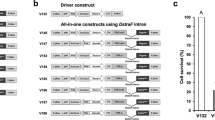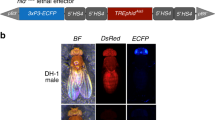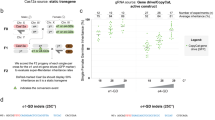Abstract
The Sterile Insect Technique (SIT) used to control insect pests relies on the release of large numbers of radiation-sterilized insects. Irradiation can have a negative impact on the subsequent performance of the released insects1,2,3,4 and therefore on the cost and effectiveness of a control program5. This and other problems associated with current SIT programs could be overcome by the use of recombinant DNA methods and molecular genetics6,7,8,9,10,11,12. Here we describe the construction of strains of the Mediterranean fruit fly (medfly) harboring a tetracycline-repressible transactivator (tTA) that causes lethality in early developmental stages of the heterozygous progeny but has little effect on the survival of the parental transgenic tTA insects. We show that these properties should prove advantageous for the implementation of insect pest control programs.
This is a preview of subscription content, access via your institution
Access options
Subscribe to this journal
Receive 12 print issues and online access
$209.00 per year
only $17.42 per issue
Buy this article
- Purchase on Springer Link
- Instant access to full article PDF
Prices may be subject to local taxes which are calculated during checkout




Similar content being viewed by others
Accession codes
References
Barry, J., McInnis, D., Gates, D. & Morse, J. Effects of irradiation on mediterranean fruit flies (diptera: tephritidae): emergence, survivorship, lure attraction, and mating competition. J. Econ. Entomol. 96, 615–622 (2003).
Lance, D., McInnis, D., Rendon, P. & Jackson, C. Courtship among sterile and wild Ceratitis capitata (Diptera: Tephritidae) in field cages in Hawaii and Guatemala. Ann. Entomol. Soc. Am. 93, 1179–1185 (2000).
Shelly, T., Whittier, T. & Kaneshiro, K. Sterile insect release and the natural mating system of the Mediterranean fruit fly, Ceratitis capitata (Diptera:Tephritidae). Ann. Entomol. Soc. Am. 87, 470–481 (1994).
Kraaijeveld, K. & Chapman, T. Effects of male sterility on female remating in the Mediterranean fruitfly, Ceratitis capitata. Proc. Roy. Soc. (Lond) B. 271, S209–S211 (2004).
Robinson, A., Franz, G. & Atkinson, P. Insect transgenesis and its potential role in agriculture and human health. Insect Biochem. Mol. Biol. 34, 113–120 (2004).
Alphey, L. Re-engineering the Sterile Insect Technique. Insect Biochem. Mol. Biol. 32, 1243–1247 (2002).
Benedict, M. & Robinson, A. The first releases of transgenic mosquitoes: an argument for the sterile insect technique. Trends Parasitol. 19, 349–355 (2003).
Handler, A. Prospects for using genetic transformation for improved SIT and new biocontrol methods. Genetica 116, 137–149 (2002).
Thomas, D.T., Donnelly, C.A., Wood, R.J. & Alphey, L.S. Insect population control using a dominant, repressible, lethal genetic system. Science 287, 2474–2476 (2000).
Horn, C. & Wimmer, E. A transgene-based, embryo-specific lethality system for insect pest management. Nat. Biotech. 21, 64–70 (2003).
Heinrich, J. & Scott, M. A repressible female-specific lethal genetic system for making transgenic insect strains suitable for a sterile-release program. Proc. Nat. Acad. Sci. (USA) 97, 8229–8232 (2000).
Gould, F. & Schliekelman, P. Population genetics of autocidal control and strain replacement. Annu. Rev. Entomol. 49, 193–217 (2004).
Keng-Hong, T. (ed.) Area-wide Control of Fruit Flies and Other Insect Pests (Penerbit Universiti Sains Malaysia, Penang, 2000).
Krafsur, E. Sterile insect technique for suppressing and eradicating insect populations: 55 years and counting. J. Agric. Entomol. 15, 303–317 (1998).
Koyama, J., Kakinohana, H. & Miyatake, T. Eradication of the Melon Fly Bactrocera cucurbitae in Japan: importance of behaviour, ecology, genetics and evolution. Ann. Rev. Entomol. 49, 331–349 (2004).
Wyss, J.H. Screw-worm eradication in the Americas – overview. in Area-Wide Control of Fruit Flies and Other Insect Pests (ed. Tan, K.H.) 79–86 (Penerbit Universiti Sains Malaysia, Penang, 2000).
Lindquist, D.A., Abusowa, M. & Hall, M.J. The New World screwworm fly in Libya: a review of its introduction and eradication. Med. Vet. Entomol. 6, 2–8 (1992).
Robinson, A. Genetic sexing strains in medfly, Ceratitis capitata, sterile insect technique programmes. Genetica 116, 5–13 (2002).
Gossen, M. & Bujard, H. Tight control of gene expression in mammalian cells by tetracycline-responsive promoters. Proc. Nat. Acad. Sci. USA 89, 5547–5551 (1992).
Salghetti, S., Caudy, A., Chenoweth, J. & Tansey, W. Regulation of transcriptional activation domain function by ubiquitin. Science 293, 1651–1653 (2001).
Damke, H., Gossen, M., Freundlieb, S., Bujard, H. & Schmid, S. Tightly regulated and inducible expression of dominant interfering dynamin mutant in stably transformed HeLa cells. Meth. Enz. 257, 209–220 (1995).
Berger, S.L., Cress, W.D., Cress, A., Triezenberg, S.J. & Guarente, L. Selective inhibition of activated but not basal transcription by the acidic activation domain of VP16: evidence for transcriptional adaptors. Cell 61, 1199–1208 (1990).
Gill, G. & Ptashne, M. Negative effect of the transcriptional activator GAL4. Nature 334, 721–724 (1988).
Shockett, P., Difilippantonio, M., Hellman, N. & Schatz, D. A modified tetracycline-regulated system provides autoregulatory, inducible gene expression in cultured cells and transgenic mice. Proc. Nat. Acad. Sci. USA 92, 6522–6526 (1995).
del Valle, J. New World screwworm (Cochliomyia hominivorax) in Mexico. Disease Information 16, 49–50 (2003).
Acknowledgements
We thank Karen Clifton for technical assistance, Roger Wood and Pedro Rendón for providing medfly strains, Al Handler, Bruno Bello and Pernille Rorth for plasmids, Bob Possee for baculovirus DNA and Helen White-Cooper for advice. This work was funded by UK Biotechnology and Biological Sciences Research Council grant 43/D16899 to L.A., with additional support from the UK Medical Research Council.
Author information
Authors and Affiliations
Corresponding author
Ethics declarations
Competing interests
Those authors affiliated to Oxitec Ltd. (as noted in the author list) are employees of this company, which therefore provided salary and other support for the research program. Also, all these authors have shares or share options in Oxitec Ltd. Both Oxitec Ltd. and Oxford University have one or more patents or patent applications related to the subject of this paper.
Supplementary information
Supplementary Fig. 1
Marker expression in transgenic medfly (PDF 90 kb)
Supplementary Fig. 2
Plasmids pLA656 and pLA928 (PDF 121 kb)
Supplementary Fig. 3
Completed predicted sequence of plasmid pLA656 (PDF 121 kb)
Supplementary Fig. 4
Completed predicted sequence of plasmid pLA928 (PDF 119 kb)
Supplementary Table 1
Derepression of tTAV in adults (PDF 54 kb)
Supplementary Table 2
Flanking sequence of piggyBac transposons (PDF 112 kb)
Rights and permissions
About this article
Cite this article
Gong, P., Epton, M., Fu, G. et al. A dominant lethal genetic system for autocidal control of the Mediterranean fruitfly. Nat Biotechnol 23, 453–456 (2005). https://doi.org/10.1038/nbt1071
Received:
Accepted:
Published:
Issue Date:
DOI: https://doi.org/10.1038/nbt1071
This article is cited by
-
Sequence and expression analysis of the spermatogenesis-specific gene cognates, wampa and Prosα6T, in Drosophila suzukii
Genetica (2023)
-
Self-limiting fall armyworm: a new approach in development for sustainable crop protection and resistance management
BMC Biotechnology (2022)
-
Next-generation tools to control biting midge populations and reduce pathogen transmission
Parasites & Vectors (2021)
-
An early female lethal system of the New World screwworm, Cochliomyia hominivorax, for biotechnology-enhanced SIT
BMC Genetics (2020)
-
Characterization of a female germline and early zygote promoter from the transcription factor bZip1 in the dengue mosquito Aedes aegypti
Parasites & Vectors (2020)



